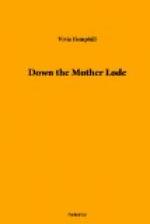“He goes to the well,
And he stands on the brink,
And stops for a spell
Jest to listen and think:
Let’s see — well, that forty-foot grave
wasn’t his, sir,
that day, anyhow.”
- Bret Harte.
Everywhere in the foothills of the Sierras there are still evidences of gold mining. High cliffs face the rivers, all that is left of hills torn down at the point of the powerful hydraulic nozzles, with great heaps of cobbles at their base which Mother Nature, even in seventy years has been unable to change or cover.
At the mouth of nearly every ravine there are countless little mounds which marked the end, or dump of the sluice-box in the placer mining. When the mound got the proper height the sluice was simply lengthened, like putting another joint onto a caterpillar — and there you were! The sluice-boxes have long since been moved away or rotted to mould but the little mounds remain, to be mansions for hustling colonies of small black ants.
The country, in various localities, is pitted with prospect holes, and the hills are pierced with drift tunnels and abandoned mines. Some of the prospect holes are mere grassy cups, others are very deep and partly filled with water.
Some of the most engrossing days of my childhood were spent in exploring these places with my two boy companions. We would fell an oak sapling across the mouth of the hole, tie a rope, usually my pony’s lariat, to the tree and slide down it to explore the depths below. If we came to a side drift we would swing into it, light our candle-lanterns and go looking for gold. We were always sure that we should yet find a forgotten cache of gold — perhaps guarded by a lonely skeleton — but we never did!
About all we ever got out of it was snake-frights (naturally, sans alcoholic origin), until we were sure, the snakes were not rattlers; baby bats, which invariably tried to bite us; swallows’ eggs, wet feet, and a good spanking if the family happened to find out what we had been up to.
I suppose that it really was a very dangerous pastime, for although sometimes the drift tunnel led us to a sunlit opening on the hillside, more often we reached a blind end and were forced to return to the main shaft and to “shin” up the rope, with from ten to forty feet of inky water waiting to catch us if we fell.
Or we went up the river to “swing the rocker” for old Ali Quong. He always pretended to drive us away, bellowing fiercely as soon as he caught sight of us, “Whassa malla you? Alle time you come see Ali Quong! Ketchem too-oo much tlouble for po-or old Chinaman” — the whole time with his wrinkled, brown face wreathed in smiles.
There we stayed the long summer afternoon, swinging the rocker while Quong shoveled in the pebbly dirt, watching him take the black sand, which held the gold, off the canvas with his little spade-like scoop, and panning it for him in the heavy iron pan, fascinated to see what we should find. Usually only a few small nuggets in a group of colors (flake gold), but once we found a good sized nugget which Quong gallantly gave me for a “Chinese New Year” gift. At dusk he sent us home, each with a bar of brown barley sugar — smelling to the blue of opium — which he fished out of one of his numerous jumpers with his long-fingered, sensitive hands.




